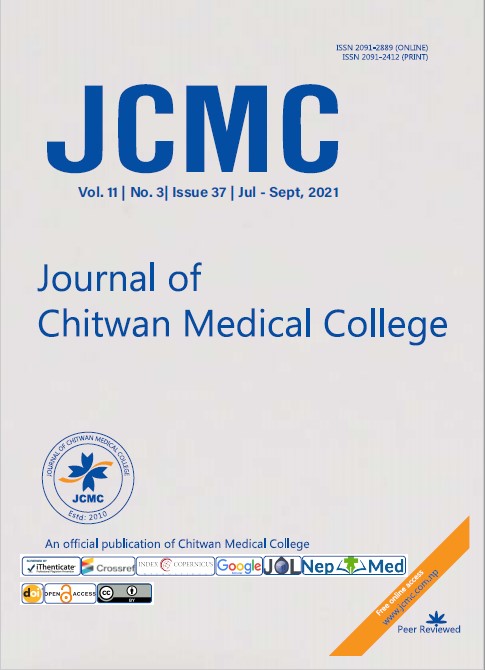Diagnosis and management of gallbladder perforation: a single-center experience
Keywords:
Cholecystitis; Cholelithiasis; Gallbladder perforation.Abstract
Background: Gall bladder perforation is one of the uncommon serious complications of cholelithiasis and cholecystitis with high morbidity and mortality. Presentation of gall bladder perforation may vary from that of similar to acute calculus cholecystitis, perforation peritonitis, palpable gall bladder mass to gall stone ileus. Here, we present our experience on the diagnosis and management of the case of gall bladder perforation.
Methods: This is the retrospective review of the records of 24 patients who received medical and/or surgical treatment with the diagnosis of gall bladder perforation at Chitwan Medical College from January 2016 to December 2020. All the patients with suspicion of gall bladder perforation underwent contrast enhanced CT scan before an operation or prior intervention.The parameters including age, gender, type of perforation, comorbidities, symptoms, diagnostic procedures, treatment modalities, morbidity, and mortality were evaluated.
Results: A total of 24 patients were included in the study during the study period. Among them 62.5% (n=15) were male and 37.5% (n=9) were female.The median age of presentation was 69 years. One patient (4.1%) had type I, 87.5% (n= 21) had type II, and 8.3 % (n=2) had type III gall bladder perforation. CT scan visualizes the defect in gall bladder wall and identifies perforation in all cases. Operative management was done in 12.5% (n=3) patients and percutaneous drainage of gallbladder was done in 87.5% (n=21). The comorbid disease was present in 83.3 % (n=20) of the cases. The median duration of hospital stay was 7 days and there was no mortality.
Conclusions: Gall bladder perforation is commonly seen in patients with acute cholecystitis and associated comorbidities. Type II gall bladder perforation is the most common type. Contrast-enhanced CT has an important role in diagnosing gallbladder perforation. Early suspicion, diagnosis, and appropriate management are of crucial importance for a better outcome in patients with gall bladder perforation.
Downloads
Downloads
Published
How to Cite
Issue
Section
License
Copyright (c) 2021 Abhishek Bhattarai, Pragya Devkota, Anup Shrestha, Keshmaya Gurung, Kishor Kumar Tamrakar, Harish Chandra Neupane

This work is licensed under a Creative Commons Attribution 4.0 International License.




